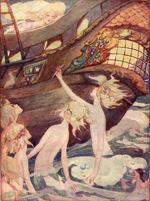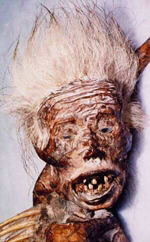
The Legend of the Mermaid, a creature with the upper body of a human and the lower body of a fish, has circulated the worlds oceans as far back as 5,000 B.C. Babylonian mythology tells of the god Ea, later referred to as Oannes by the Greeks, who was depicted as having the torso of a man and the lower body of a fish. These unique creatures have been sighted in literally every ocean on Earth; accounts have come from such diverse geographical locations as Europe, Asia, Africa and the Middle East. The Ancient Philistines, and later the Phoenicians, considered a half human half fish named Dagon to be their primary deity.
Evan the Sumerians believed it was a mermaid who rose from the ocean depths to educate man kind. The Mermaid has been described as both beautiful and repulsive, with tempers to match. The diverse personalities of the Mermaid can be seen in the reported misanthropic deeds attributed to the Adaros and Sirens, or in the significantly more amiable personalities of the Nereids chronicle in Greek mythology.  One of the earliest scientific accounts of the mermaid was documented by the great historian Pliny The Elder in 586 A.D. Pliny the Elder was convinced of the existence of Mermaids and described them as “rough and scaled all over.” Since that time, and well before, thousands of sailors across the globe have reported seeing the Mermaid swimming off the bows of their ships. Even the famous Christopher Columbus reported an encounter with a Mermaid; in January of 1493 Columbus reported that he saw three Mermaids frolicking in the ocean just off Haiti.
One of the earliest scientific accounts of the mermaid was documented by the great historian Pliny The Elder in 586 A.D. Pliny the Elder was convinced of the existence of Mermaids and described them as “rough and scaled all over.” Since that time, and well before, thousands of sailors across the globe have reported seeing the Mermaid swimming off the bows of their ships. Even the famous Christopher Columbus reported an encounter with a Mermaid; in January of 1493 Columbus reported that he saw three Mermaids frolicking in the ocean just off Haiti.
In Columbus’s account he stated that the creatures “came quite high out of the water” but were “not as pretty as they are depicted, for somehow the face looked more like a mans.” In the antiquated historical text known as the “Speculum Regale” also known as the King’s Mirror, which was written in Norway around 1250, the Mermaid is described not as a beautiful women, but more as a semi aquatic Neanderthal like creature.  This Neanderthal like version of the Mermaid is said to have large hands and fingers which are bound together by a web like membrane. The creatures face is described as having a large and terrifying face, a sloping forehead, wide brows, a large mouth and wrinkled cheeks. Below the creatures waist line is the body of a fish complete with scales, fins and a tail. Reports of this creature suggest that it is rarely spotted except before the coming of a violent storm. Sailors believe that the creature’s behavior before a storm will determine while the crew will come out of the storm alive. The Mermaid will dive into the waves and reappear minutes later with a fish in it hands, if the creature then turns toward the ship, playing with the fish or throwing it at the ship, the sailors believe that they will suffer a great loss of life. But if the Mermaid eats the fish or throws it into the sea away from the ship the crew will have high hopes that their lives will be spared.
This Neanderthal like version of the Mermaid is said to have large hands and fingers which are bound together by a web like membrane. The creatures face is described as having a large and terrifying face, a sloping forehead, wide brows, a large mouth and wrinkled cheeks. Below the creatures waist line is the body of a fish complete with scales, fins and a tail. Reports of this creature suggest that it is rarely spotted except before the coming of a violent storm. Sailors believe that the creature’s behavior before a storm will determine while the crew will come out of the storm alive. The Mermaid will dive into the waves and reappear minutes later with a fish in it hands, if the creature then turns toward the ship, playing with the fish or throwing it at the ship, the sailors believe that they will suffer a great loss of life. But if the Mermaid eats the fish or throws it into the sea away from the ship the crew will have high hopes that their lives will be spared.
Most researchers now believe that the stories which sailors have told and retold over the centuries regarding the existence of the Mermaid are most likely an example of misidentification. These researchers believe that these accounts by the sailors are accounts of actual sightings of more common marine animals, such as the manatee, dugongs or the now extinct Stellar’s Sea Cow. Other researchers believe that the Mermaid is an actual creature which dwells in the depths of the oceans and has either become very wary of man kind or become extinct in resent years due to the over pollution of the words oceans.  Some even believe that the lost city of Atlantis is inhabited by these mythical creatures. It is hard to believe, no matter how long a sailor was at see, that something like the manatee or the sea cow could have been mistaken for a beautiful women, leaving some to believe that there is more to the Mermaid legend than just a case of misidentification.
Some even believe that the lost city of Atlantis is inhabited by these mythical creatures. It is hard to believe, no matter how long a sailor was at see, that something like the manatee or the sea cow could have been mistaken for a beautiful women, leaving some to believe that there is more to the Mermaid legend than just a case of misidentification.
The Evidence
Beyond eyewitness sightings of the Mermaid there remains no physical evidence of the creature’s existence. Although many of the witnesses who report sighting the Mermaid are highly credible, until modern science has an actually corpse, not another hoax like the Feejee Mermaid, the creature will remain nothing but a legend.
The Sightings
•First Century AD, Pliny the Elder writes about Nereids – women with rough scaly bodies like fish, a mythological precursor to mermaids.
•Fifth Century AD, Physiologus in his Bestiary describes the real mermaid with the upper body of a woman and the lower of a fish, split at about the navel. The book is a study of animals and their natures and remains influential until the 18th century.
•13th Century, Bartholomew Angelicus in his book De Propietatibus Rerum described the mermaid as a femme fatale stealing sailors from their ships. Click here for more on the medieval mermaid.
•1493, January 4, Christopher Columbus reports seeing three mermaids playing about and jumping out of the water. He says, "They were not as beautiful as they are painted, although to some extent they have a human appearance in the face...."
•1560, Bosquez, aide to the Viceroy of Goa, performed autopsies on 7 mermaids caught by fishermen in Ceylon.
•1599, in the book Historia Monstrorum a mermaid and her mate are reported embracing near the Nile River delta.
•1608, June 15, Henry Hudson, explorer and discoverer of the Hudson River, records seeing a mermaid near Russia. He wrote in his log: Two crew members - Thomas Hilles and Robert Rayner - sighted a mermaid at 75° 7' N, and shouted at the rest of the crew to come and look. Hudson further recorded it as having a "tail of a porpoise and speckled like a mackerel." She was "looking earnestly on the men" who gathered on the side to see her. The description Hudson wrote says she had very white skin, "speckled like a macrell" (mackerel), long black hair, white skin and a woman's breasts - with the tail of a porpoise.
•1614, John Smith sees a mermaid off the coast of Massachusetts
•1718, a "sea wife" is caught off the island of Borneo and put in a large vat, where it died after a few days. It was heard to utter cries like a mouse.
•1739, sailors of the ship Halifax caught and ate several mermaids in the East Indies. Said they tasted like veal.
•1811, a farmer near Kintyre reported spotting a real mermaid washing herself and combing her hair.
•1830, a farm woman in the Outer Hebrides spotted a mermaid frolicking in the water. They were unable to capture her alive but did manage to kill her with a rock. The corpse was seen and described in detail by Alexander Carmichael, a well-known scholar.
•1842, Phineas T. Barnum displays the famous Feejee Mermaid at his American Museum on Broadway in New York City.
•1857, June 4, a reliable report of a real mermaid with "full breast, dark complexion and comely face" seen off the coast of Britain.
•1947, Island of Muck, 80-year-old man reports seeing a real mermaid sitting on a lobster trap and combing her hair.
•2004, wild internet reports of a mermaid corpse seen in Chennai, India, after the famous Christmas tsunami. Photographs were included, but research shows that the pictures had been circulating for some time before the tsunami.
The Stats – (Where applicable)
• Classification: Hybrid
• Size: Relatively the same height of a human women
• Weight: See Above
• Diet: They reportedly eat fish
• Location: The oceans world wide
• Movement: Swimming
• Environment: Deep Ocean
|